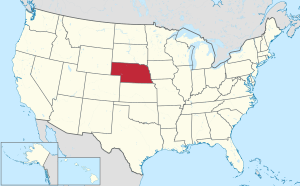Merrick County, Nebraska
Merrick County | |
|---|---|
 Merrick County courthouse in Central City | |
 Location within the U.S. state of Nebraska | |
 Nebraska's location within the U.S. | |
| Coordinates: 41°10′N 98°02′W / 41.17°N 98.03°W | |
| Country | |
| State | |
| Founded | 1858 |
| Seat | Central City |
| Largest city | Central City |
| Area | |
| • Total | 495 sq mi (1,280 km2) |
| • Water | 10 sq mi (30 km2) 1.99% |
| Population (2000) | |
| • Total | 8,204 |
| • Density | 20/sq mi (7/km2) |
| Website | www |
Merrick County is a county located in the U.S. state of Nebraska. As of 2000, the population was 8,204. Its county seat is Central CityTemplate:GR.
Merrick County is part of the Grand Island, Nebraska Micropolitan Statistical Area.
In the Nebraska license plate system, Merrick County is represented by the prefix 46 (it had the forty-sixth-largest number of vehicles registered in the county when the license plate system was established in 1922).
Geography
According to the U.S. Census Bureau, the county has a total area of 495 square miles (1,281 km²), of which, 485 square miles (1,256 km²) of it is land and 10 square miles (26 km²) of it (1.99%) is water. It is also the most oddly shapped county in the United States.
Adjacent counties
- Platte County, Nebraska - (Northeast)
- Polk County, Nebraska - (East)
- Hamilton County, Nebraska - (South)
- Hall County, Nebraska - (Southwest)
- Howard County, Nebraska - (West)
- Nance County, Nebraska - (North)
History
Merrick County was formed in 1858. It was named for Elvira Merrick, the maiden name of the wife of territorial legislator Henry W. DePuy, who introduced the bill creating the county.[1]
When first formed, the county was bounded on the south by the Platte River, and by straight lines on the north, east, and west. It thus included 180 square miles (470 km2) of the Pawnee Reservation, established one year before the county. In 1873, the state legislature removed these reservation lands from the county, leaving it with a jagged northern border from which narrow panhandles extended northward from the northeast and northwest corners. In 1897, the Pawnee Reservation became Nance County.[2]
Demographics
| Merrick County Population by decade | |
|
1860 - 109 | |
As of the censusTemplate:GR of 2000, there were 8,204 people, 3,209 households, and 2,307 families residing in the county. The population density was 17 people per square mile (7/km²). There were 3,649 housing units at an average density of 8 per square mile (3/km²). The racial makeup of the county was 98.32% White, 0.22% Black or African American, 0.10% Native American, 0.21% Asian, 0.01% Pacific Islander, 0.67% from other races, and 0.48% from two or more races. 2.05% of the population were Hispanic or Latino of any race.
There were 3,209 households out of which 33.30% had children under the age of 18 living with them, 61.10% were married couples living together, 6.50% had a female householder with no husband present, and 28.10% were non-families. 25.00% of all households were made up of individuals and 13.10% had someone living alone who was 65 years of age or older. The average household size was 2.51 and the average family size was 2.99.
In the county the population was spread out with 27.50% under the age of 18, 6.40% from 18 to 24, 24.70% from 25 to 44, 23.80% from 45 to 64, and 17.50% who were 65 years of age or older. The median age was 39 years. For every 100 females there were 95.90 males. For every 100 females age 18 and over, there were 94.90 males.
The median income for a household in the county was $34,961, and the median income for a family was $39,729. Males had a median income of $26,998 versus $19,828 for females. The per capita income for the county was $15,958. About 7.00% of families and 8.90% of the population were below the poverty line, including 9.70% of those under age 18 and 9.20% of those age 65 or over.
Communities
City
Villages
Other place
Townships
- Central
- Chapman
- Clarksville
- Lone Tree
- Loup
- Mead
- Midland
- Prairie Creek
- Prairie Island
- Silver Creek
- Vieregg
References
- ^ "Records of Merrick County among holdings of NSHS Library, Lincoln, NE". NEGenWeb Project. Retrieved 2009-12-28.
- ^ "Merrick County's 100th Year: 1858-1958". NEGenWeb Project. Retrieved 2009-12-28.

